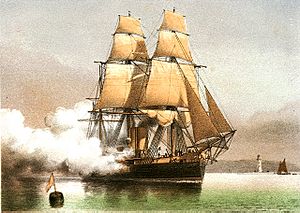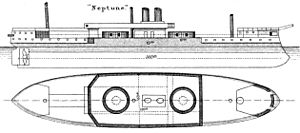HMS Neptune (1874) facts for kids
 |
|
Quick facts for kids History |
|
|---|---|
| Name | HMS Neptune |
| Namesake | Neptune |
| Builder | J & W Dudgeon, Cubitt Town, London |
| Cost | £600,000 |
| Laid down | 1873 |
| Launched | 10 September 1874 |
| Completed | 3 September 1881 |
| Acquired | February–March 1878 |
| Commissioned | 28 March 1883 |
| Fate | Sold for scrap 15 September 1903 |
| General characteristics | |
| Type | Ironclad turret ship |
| Displacement | 8,964 long tons (9,108 t) |
| Length | 300 ft (91.4 m) (p/p) |
| Beam | 63 ft (19.2 m) |
| Draught | 25 ft (7.6 m) |
| Installed power | 8,832 ihp (6,586 kW) |
| Propulsion | 1 shaft, 1 2-cylinder Trunk steam engine, 8 rectangular boilers |
| Sail plan | Barque-rigged |
| Speed | 14 knots (26 km/h; 16 mph) |
| Range | 1,480 nmi (2,740 km; 1,700 mi) at 10 kn (19 km/h; 12 mph) |
| Complement | 541 |
| Armament |
|
| Armour |
|
HMS Neptune was a powerful warship from the past. It was an ironclad turret ship, meaning it had strong metal armor and rotating gun towers. This ship was first built in Britain for Brazil. But in 1878, the Royal Navy (Britain's navy) bought her.
It took three years to change the ship to fit the Royal Navy's needs. Neptune started its first duty in 1883 with the Channel Fleet. Later, it moved to the Mediterranean Fleet in 1885. After a refit in Portsmouth in 1886–87, Neptune became a coastguard ship. It stayed at Holyhead until 1893. Then, it was put into reserve in Portsmouth.
In 1903, while being towed to be broken up, Neptune had a series of accidents. It accidentally rammed HMS Victory, which was a training ship. It also crashed into HMS Hero and almost hit other ships. Neptune was finally scrapped in Germany in 1904.
Contents
Building and Design of HMS Neptune
HMS Neptune was designed by Sir Edward Reed in 1872. It was meant for the Imperial Brazilian Navy and was first called Independencia. The ship was designed to be like a bigger version of HMS Devastation, but with masts for sails.
Adding masts meant the ship needed a forecastle (front deck) and a poop deck (back deck). These decks made it hard for the ship's main guns to fire straight forward or backward. This was a big problem because being able to fire in all directions was a key feature of the original design. Instead, the ship ended up looking more like HMS Monarch.
Why Britain Bought the Ship
During the Russo-Turkish War in 1877–78, there was a lot of tension between Russia and Great Britain. Britain worried that Russia might take over the Turkish capital, Constantinople. To prepare for a possible war, Britain bought several warships that were still being built. One of these was Independencia in 1878.
Brazil sold the ship for £600,000. This was almost twice the price of a similar ship, Devastation, bought earlier. Britain then spent another £89,172 to upgrade Neptune to its own standards. However, some British sailors thought Neptune was "a white elephant". This means it was very expensive but not very useful. They said it had many problems and was sometimes dangerous.
Ship Size and Handling
Neptune was about 300 feet (91.4 m) long. It was 63 feet (19.2 m) wide and had a draft (how deep it sat in the water) of 25 feet (7.6 m). The ship weighed about 8,964 long tons (9,108 t).
Neptune was not very good at handling rough seas. It was often wet on deck, hard to steer, and rolled a lot. It even had a 12-foot (3.7 m) skylight over the officers' living area. This skylight often caused the room to flood when the ship was at sea.
Ship's Power and Speed
Neptune had one large 2-cylinder steam engine. This engine powered a single 26-foot (7.9 m) propeller. Eight large boilers created steam for the engine.
The engine was designed to produce 8,000 indicated horsepower (6,000 kW) of power. During tests in 1878, it actually produced 8,832 ihp (6,586 kW). This power allowed Neptune to reach a top speed of 14.65 knots (27.13 km/h; 16.86 mph). The ship could carry 670 long tons (680 t) of coal. This was enough to travel 1,480 nmi (2,740 km; 1,700 mi) at 10 knots (19 km/h; 12 mph). However, one admiral said the ship used "a coal-mine daily" because it burned so much fuel.
Neptune also had sails, like a barque. But its two funnels were too close to the main mast. This caused the sails and ropes to wear out quickly. During a refit in 1886, the ship's masts and sails were removed. They were replaced with simple pole masts that had small platforms for lookouts.
Weapons and Armor
The original plan for Neptune included four 12-inch guns and two 8-inch guns. But when the British Royal Navy took over, they changed the weapons.
Ship's Guns and Torpedoes
HMS Neptune was fitted with four powerful 12.5-inch muzzle-loading rifles. Two of these huge guns were in each rotating gun tower. It also had two 9-inch rifled muzzle-loading guns at the front of the ship. These guns could only turn 45 degrees to the side. The ship also carried six smaller 20-pounder guns for firing salutes.
In addition to guns, Neptune had two 14-inch (356 mm) torpedo tubes. These were on the main deck, one on each side. They were used to launch Whitehead torpedoes.
The 12.5-inch guns fired shells that weighed 809 pounds (367.0 kg). The gun itself weighed 38 long tons (39 t). These guns could shoot shells at 1,575 ft/s (480 m/s). They were strong enough to break through about 18.4 inches (467 mm) of iron armor. The 9-inch guns fired 254-pound (115.2 kg) shells at 1,420 ft/s (430 m/s). They could penetrate about 11.3-inch (287 mm) of armor. The blast from the main guns was so strong that it could damage the deck below. So, the amount of gunpowder used for each shot was reduced to prevent damage.
Ship's Protective Armor
Neptune had a full waterline belt of strong iron armor. This belt was 12 inches (305 mm) thick in the middle of the ship. It became thinner towards the ends, going down to 10 inches (254 mm) and then 9 inches (229 mm) thick. This armor belt went 5 feet 6 inches (1.7 m) above the water and 3 feet (0.9 m) below it.
A strong armoured citadel (a protected central area) was 112 feet (34.1 m) long. It protected the bases of the gun towers, the funnels, and the engine and boiler rooms. The sides of this citadel were 10 in (254 mm) thick. It was closed off by thick bulkheads (walls) that were 8 inches (203 mm) thick. The guns at the front of the ship were protected by a patch of 6-inch (152 mm) armor.
The front of the gun towers had 13 inches (330 mm) thick armor. The sides were 11 inches (279 mm) thick. Behind this armor was 13–15 inches (330–381 mm) of strong teak wood. The armored deck was 2–3 inches (51–76 mm) thick outside the citadel and 2 inches (51 mm) thick inside it. Neptune also had a conning tower (a protected control room) with 6–8 inches (152–203 mm) of armor. This was the first time a British ironclad had such a well-protected control area.
Service History of HMS Neptune
HMS Neptune was started in 1873 for the Brazilian Navy. It was built by J & W Dudgeon in Cubitt Town, London. The shipyard tried to launch her on July 16, 1874, but she got stuck. A second try on July 30 also failed, and the ship was badly damaged. She was finally launched on September 10, after being made lighter. Then, she was towed to another company, Samuda Brothers, for repairs and to be finished. The cost of this accident caused Dudgeons to go bankrupt in 1875.
Independencia had its sea trials in December 1877. On December 22, she ran aground in the River Thames at Greenwich, Kent. She was freed on December 25 and towed to Greenhithe, Kent. On February 23, 1878, a British steamship called Firebrick crashed into Independencia at Greenhithe, causing minor damage.
The Royal Navy bought the ship in March 1878 and renamed her Neptune, after the Roman god of the sea. She was then taken to Portsmouth for changes to her weapons and other equipment. These changes took a long time, finishing on September 3, 1881.
Neptune was commissioned (put into active service) on March 28, 1883. She served with the Channel Fleet. In 1885, she moved to the Mediterranean Fleet. But she returned to Portsmouth in July 1886 for another refit. In May 1887, the ship was assigned as the guard ship for the 1st Class Reserve at Holyhead.
Neptune was paid off (taken out of active service) and put into reserve in November 1893 in Portsmouth. In April 1902, she was moved from the Fleet reserve to the Dockyard Reserve. The ship was sold for £18,000 on September 15, 1903, to be scrapped.
Final Journey and Accidents
On October 23, 1903, Neptune was being towed out of Portsmouth by two tugboats. A storm hit, and the cables connecting her to the tugs broke. The strong winds and tide pushed her back into the harbor. She narrowly missed a training ship called HMS Racer.
Neptune then lightly hit the training ship Sunflower. After that, she crashed into the left side of HMS Victory, making a hole in its lower deck. The tides and winds then pushed Neptune towards HMS Hero, and she came to rest against Hero's bow (front). Neptune was finally broken up in Lemwerder, Germany, in 1904.


